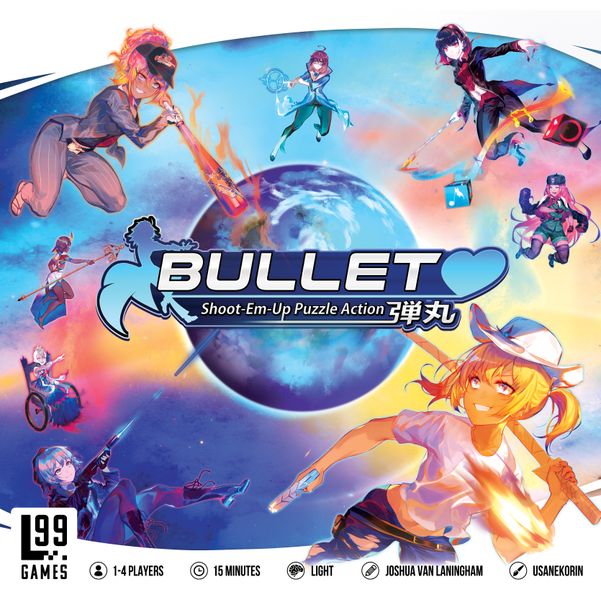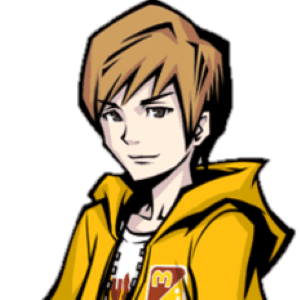Upon opening this review, I am certain my most regular readers will think: “You just reviewed a bullet hell shoot-em-up magical girl inspired video game in January! Are you just picking a board game with the same thematics in order to make your first board game review harmonize with your first video game review?” First of all, thank you for your continued interest in my writings! Second of all yes that is EXACTLY what I am doing today, good on you for noticing. That being said, don’t run off too quickly. Today’s board game is pretty under the radar and unlike any tabletop experience I’ve had before, and it just might pique your interest too.

Developed and published by Joshua Van Laningham and the Level 99 Games team and released in March 2021, Bullet🤍 is an action-puzzle game released for kitchen tables and local game stores. Its premise involves picking one of eight powerful (and quirky) heroines and blasting your way through competitive PvP and PvE puzzles.
The gameplay of Bullet🤍 is about as unique as they come, so I will try to detail the various game elements as much as possible. The game is centered around a bag of 140 “bullet” tokens which is blindly drawn from (think drawing Scrabble letters) at the beginning of each round of play and placed into each player’s personal bag called the “current.” During the round it is the player’s job to blindly draw bullets one by one from their current and place them onto their game board, with the color and number of each bullet telling a player in what column and how many empty spaces down to place them. Bullets that fall too far damage you, so the basic goal of the game is to send bullets to opponents’ boards while keeping your own board under control in order to be the last one standing. The context of this win condition changes from mode to mode, but ultimately survival is the key goal no matter what kind of game of Bullet🤍 you choose to play. You are not completely at the mercy of drawing bullets though, as each of the game’s playable characters offer wildly different tools to overcome the storm. Each character has a unique deck of “patterns” which clear bullets from your board provided you manipulate the bullets into forming their configurations. They each also have a unique passive ability which has a huge impact on how a player will choose when and where to clear bullets, and half of the characters even introduce new pattern conditions altogether. Finally all of the characters have a board of actions they can take to execute their strategies that draw on a limited number of “Action Points” and include general actions, actions that interact specifically with their passives, and bonuses for clearing bullets with stars on them.
In summary, Bullet🤍 is about playing the same puzzle game by different rules from everyone else, and it’s the fun of approaching the same problems with various solutions that makes the game such a joy to play over and over. The main character Esfir only has a bigger hand size, but is refreshing in her simplicity compared to the craziness of the rest of the cast. The musician Adelheid has strict color requirements on patterns but can generate wild bullets which makes her escalate into a cascade of easy clears. Inventor Ling-Ling has unique pattern symbols which add up the numbers of the bullets in her formations to determine the strength of her attacks. There’s even a bizarre triangle worshipper who rains down “3” bullets on opponents if you can figure out how to leverage her powers in spite of her limited resources and tricky (and very on brand) pattern shapes. Where your average puzzle game gets stale from a limited pallet of playstyles, Bullet🤍 thrives on offering as much variety as possible.
The game offers a wide selection of modes, catering to this spirit of variety further still. The basic mode Free-for-all sees players send their cleared bullets to their opponents current in the next round, and attempt to outlast everyone else. These duels can be made even more crazy with a 3 minute timer, forcing players to frantically balance between managing their board and actually drawing every bullet in their current before time runs out. Though the game itself may feel a bit single-player in some sense, being sent a huge number of bullets makes the efforts of your opponents quite tangible, and motivates me to stay on guard and get ready to clear aggressively. If you’ve got four players and really want to increase the interaction levels at the table though, then Team mode is an excellent choice. Players divide themselves into teams of two and place three team actions on their action boards where power-ups would usually go (oh yeah, there are power ups in the game but they’re only ever used in Free-For-All and are pretty self explanatory). Rules then proceed as normal, but you only send bullets to the other team, and you’re often strategizing with your partner on how to spend Action Points to maximize clears and survive. Your health is even shared between the two of you, so if you ever run out of life you just keep playing and place bullets that hit you in your partner’s life. This mode is extremely fun, as the extra tactics available really give it a lot of depth.
If you fancy playing alone or competing in a less confrontational manner, then there’s Score Attack mode, which sees you try to survive as many rounds as you can, with cleared bullets causing more bullets to get thrown your way. While the dynamic of this mode is a little odd in that clearing low amounts of bullets is actually very helpful for surviving, it’s a great way to learn the mechanics of heroines you are unfamiliar with. Finally, Boss mode sees one or more players attempt to solve challenge puzzles, with the bosses themselves actually being printed on the flip side of each heroine and being themed around that character using their full power against you. This is easily one of the most fun ways to play the game, but I do think it’s better as a single player mode than a multiplayer one. While you do get to use team actions as a group, playing in a group doesn’t really change how difficult the fight is unless the players are used to strategizing around team actions, and if someone gets knocked out early in the fight they kinda just have to wait until everyone else finishes the game for what can be a pretty lengthy amount of time (this is true for the other modes, but it is particularly salient here). I personally find more enjoyment in honing my understanding of how to beat each boss without the extra work of coordinating with others.
As for the game’s presentation, the game boards, action boards, and pattern cards are very cleanly designed to help make their functions quickly understood, thanks in large part to the reference cards included in the box. The passive ability boards are also perfectly clear and useful, but differ in that they feature illustrations of the game’s anime heroines (and their boss forms), and these are the real artistic highlights of the game. Each character is rendered in a loud, flashy, prismatic art style that immediately conveys their individual appeal, and while this style certainly isn’t for everyone it suits the game’s aesthetics to a T. It’s also worth noting that while the heroines aren’t 100 percent modest across the board, the game does a good job designing each girl to draw attention to what matters about their character rather than pandering to cheap eros. Showing skin is a tool instead of a crutch, and even what skin is shown isn’t all that much by today’s standards.
The heroine/boss boards and patterns also include some flavor text and the rulebook has a small lore section to introduce what each character is about. I won’t cover this in too much detail though, as while the lore in the rulebook is actually fairly detailed it is also not very wide in scope, and doesn’t seem to be meant to be taken too seriously besides. It is tricky to pinpoint any given moral or message out of just character biographies and a very absurd cosmological record. The developers do plan to release more content in the same universe as Bullet🤍 (called Cycle 617) so maybe one day I will be able to critique the lore properly but for now there just isn’t enough of it for me to get super analytical. What’s there certainly does its job, I just can’t pass significant judgement on it. What I can talk about though is the game’s music, because the developers actually released a full ost of three minute timers for free-for-all themed around each character. This soundtrack is incredibly varied, with different tracks leaning into different tempos and emotions. It could have been just a lot of fast paced music to get your blood pumping, but I was impressed by the composer’s restraint in pursuit of writing music that fit the characters. Needless to say the music is great, and definitely worth a listen if you’re into game soundtracks.
So at the end of the day, Bullet🤍 is a fun and unique board game with a good balance of luck and skill and a huge amount of ways to play. Your mileage may vary on the various modes depending on your particular group’s needs, but overall this is one game unlikely to stay on the shelf for long if it clicks with you. Sometimes life throws more than we think we can handle our way much like the many bullets pulled from the current, but with trust in God and by finding the courage to take action in managing the mess, there’s always a way to clear your sights and overcome life’s challenges.
Scoring: 90%
Gameplay: 4/5
Art and Graphics: 5/5
Music: 5/5
Replayability: 5/5
Morality/Parental Warnings
Bullet🤍’s thematics involve characters who each use magical powers in one way or another. A few characters such as Ekolu, Mariel, and Rie wear clothing that show varying degrees of skin. The character Young-Ja is a ghost, and her boss form is called “Hell On Wheels.” The rulebook lore features a cosmology that has a polytheistic creation myth, and the character Ekolu leads a cult that venerates triangles. The lore is obviously not front and center, but I felt it was worth mentioning.
